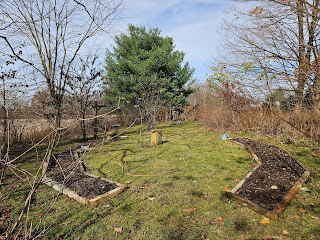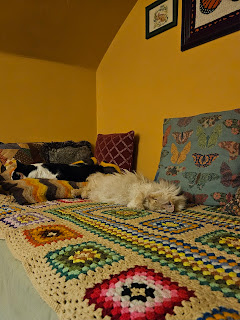We stopped by Claridon Prairie this fall and took in the sight of a thin prairie remnant stretching one mile east along railroad tracks. If you don't know about it and want to, check it out here. This little prairie strip contains more than 75 species of plants and they offer us an example to emulate or to learn from. Standing there I felt simultaneous horror and joy. Horror at the unbelievable take-all attitude of certain humans, but also joy in the wisdom and genetics of the plants in front of us.
Land restoration is an obsession for us; it works so well and gives such great joy we can hardly think of anything else. We each used to have so many diverse interests and as we get older and we observe the planet around us, we find our interests narrowing to planet work and planet observation. It's a delight to have this clarity and this action we can take for feelings of helplessness and grief and love and joy!
We humans have some mighty land restoration work to do everywhere and private land is where much of this restoration must take place. It feels good to be needed by Planet Earth doesn't it? So many of us feel like Earth would be better off without our species, but we MUST remember, we came from nature. There is no questioning this. The wisdom of ancient people exists. The science and history exist. In Biophilia E.O. Wilson says society gave us an evolutionary advantage and that's when our species diverged greatly from nature and so it seems within society (especially a fair and equal society) is where the path back might come from.
This autumn we spread seed and planted roots for rare and at-risk forest plants.
Our personal resilience in life comes from action and so we created new woodland plant propagation beds. In this new area, we packed the soil full of hopes and dreams and black cohosh, bloodroot and white trillium roots. Planting the future we are. Planting plants to repopulate the lands we call home is the plan, but also to share to repopulate other lands too.
Holding these roots felt full of power! Defiance! Resistance! We will not give up. Not ever. The restoration here is small scale, but it's revolutionary.
Roots left to right: black cohosh, bloodroot, white trillium:

Steve and I met and connected through a shared interest in nature restoration and nature observation and it's what unites us. To find shared interest amidst love is a great gift. This autumn we noticed no barred owls calling and the red-shouldered hawks we still heard, but much farther away than our backyard; strange! These two bird calls have been the backdrop of our entire 14 years living here. What changed? It wasn't until one evening I sat reading next to the open window that I knew why. It came in two note calls and then additional calls. All "hoots." OMG! I went flying down the stairs to Steve to tell him, "GREAT-HORNED OWL!" Yes, a great-horned owl moved into the neighborhood. Will they stay? We don't know, but I'm certain some nights not too long from now, we will stand in the cold and listen and we will greet them as neighbors.
During the duration of our living here, we've also never heard coyotes. Never once. We used to live in a place where coyotes ran the drained river valley behind our house and sang and sang. It was a thrill to hear them so it was a surprise when we never heard them here. We have farm land surrounding us here as well, but we also find much more intolerance of this species here. Once a coyote showed up on our wildlife cam and we rooted for them, so glad to think of them skirting the edges of the land, staying in the shadows, trying to survive. This fall, two nights in a row, we heard two singing coyotes right out our open windows. JOY! Our neighbors messaged us equally excited and we all agreed to tell no other humans. The coyotes told everyone they were here, but maybe everyone else was otherwise occupied and didn't hear the message: "We are here. We survive."
Today we are cloudy and cold, but we are within grasp of the winter solstice. There are just a few seconds of daylight left to lose and on gray days, sunny days, long days, short days, we smile and think of the great-horned owl and coyotes. We notice the shift in the land we live on as it embraces the changing plants and changing web of life and perhaps notices the humans that are working to be kin again. We explore the lands around Ohio and always find magnificence in one form or another. It's everywhere when we are open: listening with our ears, feeling with our feet, our exposed skin, looking with our eyes.
When we don't chatter too much, we notice things. Like this small forest with beautiful, old trees and an entire shrub understory full of spicebush. Rarely do we see abundant shrub layers in forests, that are not invasive and non-native, and we've been offered many reasons, but so far, the reasons don't mesh with what we've read historically and what we observe. This is a topic we will continue to explore. Below, Steve stands next to a shagbark hickory and associated white oaks with an abundant shrub layer of spicebush.
Disturbance is a major player in the way ecosystems shape themselves and offer habitat to shifting species. Was the spicebush filled forest disturbed or only lightly disturbed? Was it tended by humans? Minnie Pearl, Luke and Alvin spent an entire week observing a major disturbance on the land where we live; disturbance anywhere is often quite difficult for some species and the disturbance here was most certainly quite difficult for us Homo sapiens. Minnie Pearl didn't really care:
But, Luke and Alvin thought hell moved into and around our house:
In the evenings when the sounds stopped, they rested and even found comfort in one another. It's a big deal around here if Alvin (white long hair) can tolerate the touch-buddy Luke.
Only two sassafras grow here on this patch of land, both planted by us. They are a common tree not far from here that can be quite abundant, but since they are not common here, we are very attached to them as we've witnessed them grow and win prior challenges. When this sassafras got caught underneath a lowering dump truck bed, I yelled, "there goes the sassafras!" with quite a bit of sorrow in my voice. The digging up and subsequent burying of so many of our other plant friends already had us in a strange state of numbness, but the contractor on the ground saw the tree when they were nearly horizonal and released them. The sassafras lives with many bruises and wounds, but so far stands on the survivor list.
The septic installation went great and just in time before the soil was too saturated for working and will be finished in the spring. Until then, we think on how we might utilize this empty space for habitat and best care for our sewage treatment system. Everything is an opportunity.
Steve got to work immediately helping the soil feel a bit of tending. The 50% pore space of noncompacted soil is currently about zero, but plants and critters and time, lots of time will heal our mark.
Restoration = relationships and we are in personal relationship with the nonhuman life here. It's a good thing. It hurts when plants and animals lose their lives because of our land use patterns or desires. As a species, we should recognize all choices have a trade off and often they are not ours to make, even though we live like they are. Honorable living. That's what it means to participate in restoration....a path to honorable living. Shared living. Shared land.
Pirate spider egg sac:
Thank you friends who participate in this necessary human work. It's wondrous to deeply know some of you and to know others are out there doing the same thing, giving your time, tending the land, fostering relationship through restoration and walking the path of honorable living. Communities of dedicated humans do wondrous work. High fives to all!
The R(evolution) of Indigenous Foodways - Chef Sean Sherman (Savanna Institute)






















































